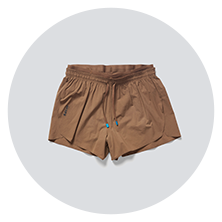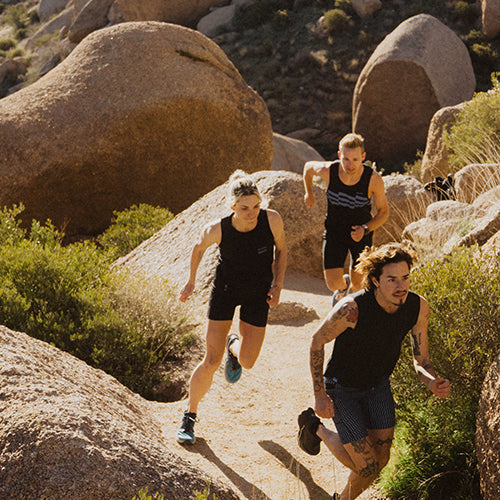CREDITS
WORDS
Calvin Van Ryzin
RUNNERS
Calvin Van Ryzin
Emily Schlebecker
Bozeman Water Treatment Plant Operator Calvin Van Ryzin runs to his water source in the Dion x Janji Snowshoe
Follow the H2O is a Janji initiative that encourages runners to research and reflect on where their drinking water comes from, plot a route to or near that source, and then share the journey with others.
In our recent collab with Dion Snowshoes, we also teamed up with local Bozeman runners Calvin and Emily to complete a winter version of Follow the H2O in Hyalite Canyon.
Calvin works for the Bozeman Water Treatment plant, so post-run, we got to pick his brain about his work, water usage, and what we can do at home to be more conscious.
 
Emily and Calvin running in Bozeman.
|
“My relationship with running impacts my work because I run in the mountains where our water comes from. When I run along the beautiful and clean water we have, it makes me proud to do my job and makes me want to work harder to conserve it.- CalvinWater Treatment Plant Operator |
Q: How long have you been running?
A: I have been running since I started middle school cross country, which is about 15 years.
Q: What’s your favorite type of running? (Event, road, trail, etc)
A: As a former college track and cross country athlete, my favorite type of running is racing on the track, specifically the mile. But since moving to Montana I have loved transitioning to trail races. I like going fast and seeing what I can push myself to do. I mostly run 5-15k races right now but I am working my way up with the goal of eventually racing an ultra.
Q: Where is your favorite place to run?
A: My favorite place to run is Sourdough Canyon in Bozeman, MT. I live and work half a mile from the trailhead so I run there a lot. I love it because it is not technical or very steep, so you can run fast on it. But it still takes you up into the mountains along a beautiful stream (which is water I treat for the city of Bozeman). It is also connected to a vast trail network which connects to other canyons and mountains (including our other water source, Hyalite canyon)
Q: Are you training for anything specific right now?
A: I just finished training for a 5k personal record and now I am starting to train for the Arches Ultra Half Marathon in Moab, Utah.

WORK/WATER
Q: What do you do?
A: I am a water treatment plant operator for the Bozeman Water Treatment Plant.
Q: Where does Bozeman’s water come from?
A: About 80% of Bozeman’s water comes from Hyalite Reservoir in Hyalite Canyon and Bozeman Creek in Sourdough canyon. These sources are supplied by snowfall which then runs off during the warmer months. About 20% of the water comes from a groundwater spring in the Bridger foothills.
Q: What does a typical day look like?
A: My typical day changes depending on if I am on operations, laboratory, or maintenance duty. When operating, I am responsible for making sure the plant is running properly by controlling water flows and chemical set points. On lab duty, I conduct water quality sampling and testing throughout the city and the plant. On maintenance duty, I perform maintenance tasks and
inspections at our plants, water intakes, and water storage reservoirs.
Q: How has working for the water treatment plant affected your daily water use?
A: Since I went to college for Water Resources Management, I was aware of water issues for years before I started working at the water treatment plant. However, moving from the midwest to the mountains has opened my eyes to the different water issues that different areas of the world face depending on their climate, geography, and water sources.
Q: Are you worried about running out of water?
A: Yes, I am worried about Bozeman running out of water. Due to population increase, hotter temperatures, and droughts, our current water resources will eventually not be able to provide all of the water that Bozeman needs. The city is looking into options to add more water supply, but we can also make our current sources last longer by taking action. About half of the city's water is used for irrigation in the summer, so that is an important area for us to reduce the gap between supply and demand. Bozeman is offering incentives for people to replace their lawns with landscaping that does not require as much water. The city is also making its own irrigation systems more efficient. During the stage two drought the city implemented this past July-October, water usage dropped by over 20%. Bozeman's water conservation department states that, "Taking action now to conserve what we have is the cheapest, most expedient, and environmentally-friendly way to thrive through drought and ensure a reliable water supply for the future. And all it takes to help is doing one thing to reduce your water use."
 
Emily and Calvin running in Bozeman.
|
“I am worried about Bozeman running out of water. Due to population increase, hotter temperatures, and droughts, our current water resources will eventually not be able to provide all of the water that Bozeman needs. The city is looking into options to add more water supply, but we can also make our current sources last longer by taking action- CalvinWater Treatment Plant Operator |
Q: Do you have any tips on how to be more responsible with your water usage at home?
A: Along with giving incentives and rebates for people who replace their lawns with more water-tolerant landscaping or install water-efficient appliances in their homes, the Bozeman water conservation department offers free products to help reduce your water usage. Also, if it's yellow, let it mellow. Every drop of water we can save counts.
Q: How does your relationship with running impact your work?
A: My relationship with running impacts my work because I run in the mountains where our water comes from. When I run along the beautiful and clean water we have, it makes me proud to do my job and makes me want to work harder to conserve it.
Q: Is there anything else you would like to share?
A: Bozeman is fortunate to have extremely high-quality water, but it is a finite resource. It is important for everyone to understand where their water comes from and act to conserve it.




















